Tomorrow, the quarter-final matches of Olympic Women’s Football 2024 will commence with four high-stakes encounters.
The United States Women’s National Team will face Japan in the opening match, followed by Spain against Colombia, Canada versus Germany, and France concluding the quarter-finals with a game against Brazil.
In the exciting group stage, the United States boasted the strongest attack with nine goals scored, followed by Germany with eight goals.
Conversely, the Nigerian team’s weakest attacking line was that of the Nigerian team, which scored only one goal, while Brazil and New Zealand each scored two goals.
On the defensive front, the Spanish team had the strongest defence, conceding only one goal.
They were followed by Brazil and Canada, each conceding just two goals.
In contrast, Zambia’s defence was the weakest,
conceding 13goals, followed by Australia’s, which conceded 10 goals.
Although these statistics and probabilities are insightful, it is widely acknowledged that knock-out matches are typically thrilling and full of surprises that can alter the course of the competition.
One such surprise could be a team leveraging set-pieces as a decisive factor to advance to the next round.
In this tactical analysis of the Olympics 2024 women’s football, we will discuss the key distinguishing tactics of the eight teams regarding set pieces and what we can wait for in these important games.
United States Vs Japan
Starting with the US Women’s National Team (USWNT), who got the full nine points in the group stage, they love flicks from the area before the near post in many different ways.
In the photo below, the opponent defends with six zonal defenders inside the six-yard line, three player-to-player markers, and a rebound defender while the USWNT targets the highlighted player, who uses her mate as a screen going around her to get rid of her marker.
Note: In basketball, a screen is the use of a mate to block the targeted player’s marker to free her.
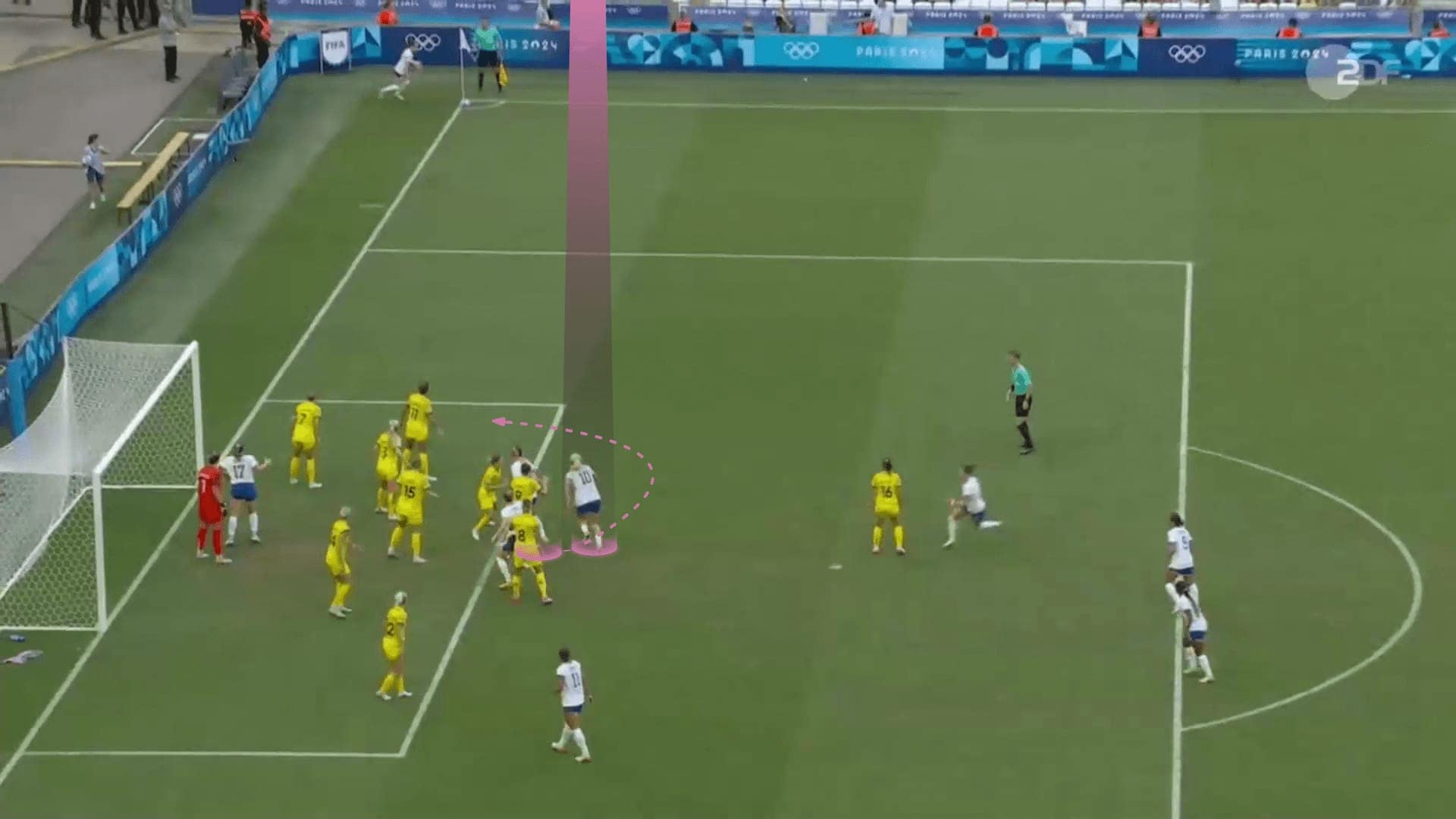
In the photo below, the screen’s effect is clear, while the other two runners have a next role to go to the near post to get the ball if it is overhit, framing the ball’s bath.
The second benefit of the targeted player’s starting position is that she comes from the first zonal defender’s blind side, meaning that she will have trouble getting her attention while tracking the ball in the air.

The plan starts to work while the orientation problem can help the targeted player intercept the ball before the first zonal defender.
A player moves to the far post to frame the goal to be ready to receive the flicked-headed pass.
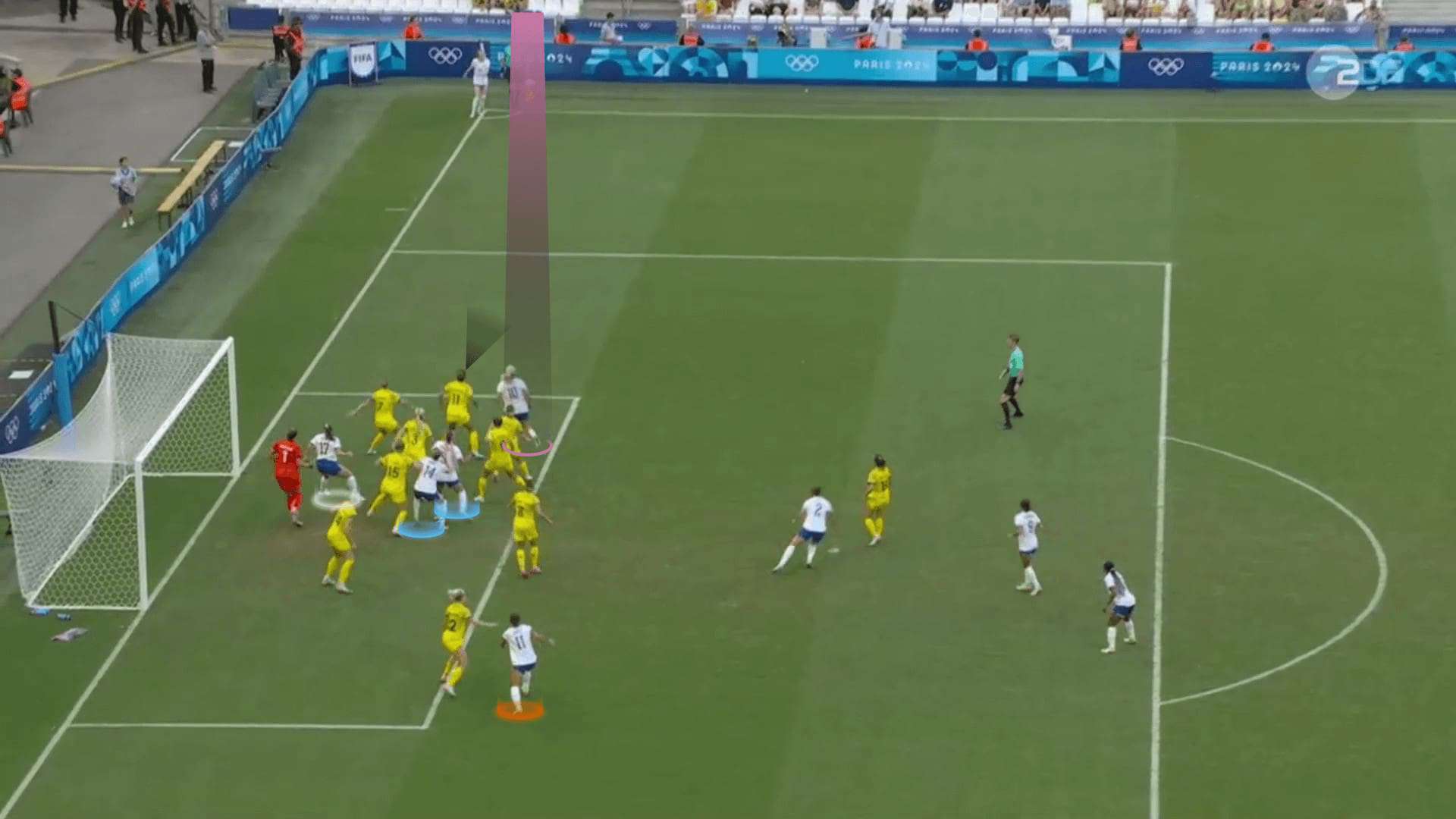
The cross wasn’t optimal, so it hit a defender’s head, but framing the ball and having a player in each valuable area—six yards, near post, middle post, and far post—helped, and the result was a goal in the end.
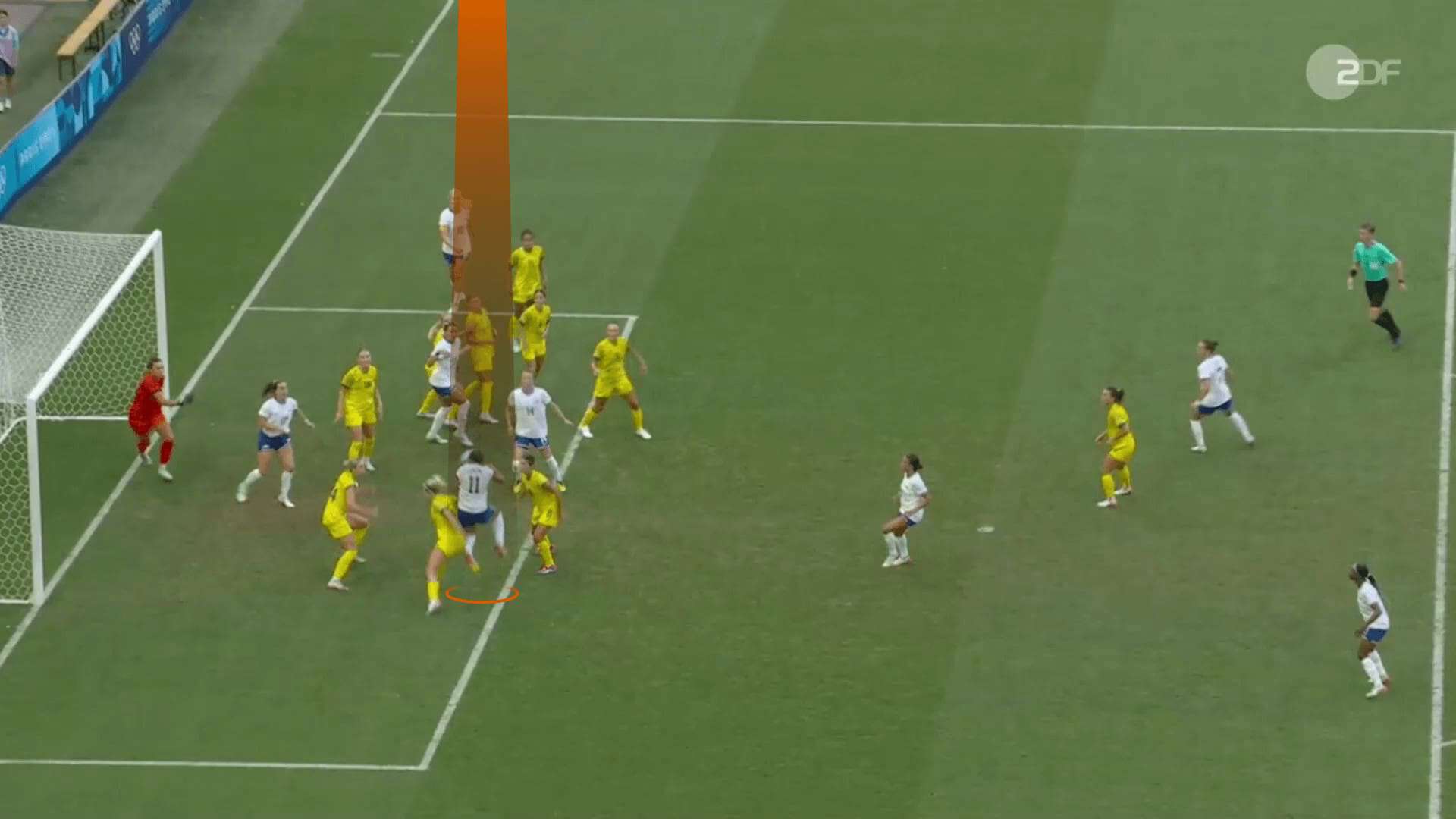
Coming to Japan, they are very dangerous at direct free-kicks having two brilliant players left and right footed: Hikaru Kitagawa and Aoba Fujino, in case of playing.
They sometimes use an additional supportive tactic: a two-player wall to obstruct the goalkeeper’s line of sight.
The goalkeeper becomes afraid to start moving unless she sees the ball because it might be shot through that attacking wall, which may open suddenly.
However, she suddenly sees the ball after already passing the wall, as in the second and third photos below, which delays her reaction, making the shot hit the net even if it isn’t in the farthest corner.
In the fourth photo, the result is a goal despite not being at the farthest point of the goal.
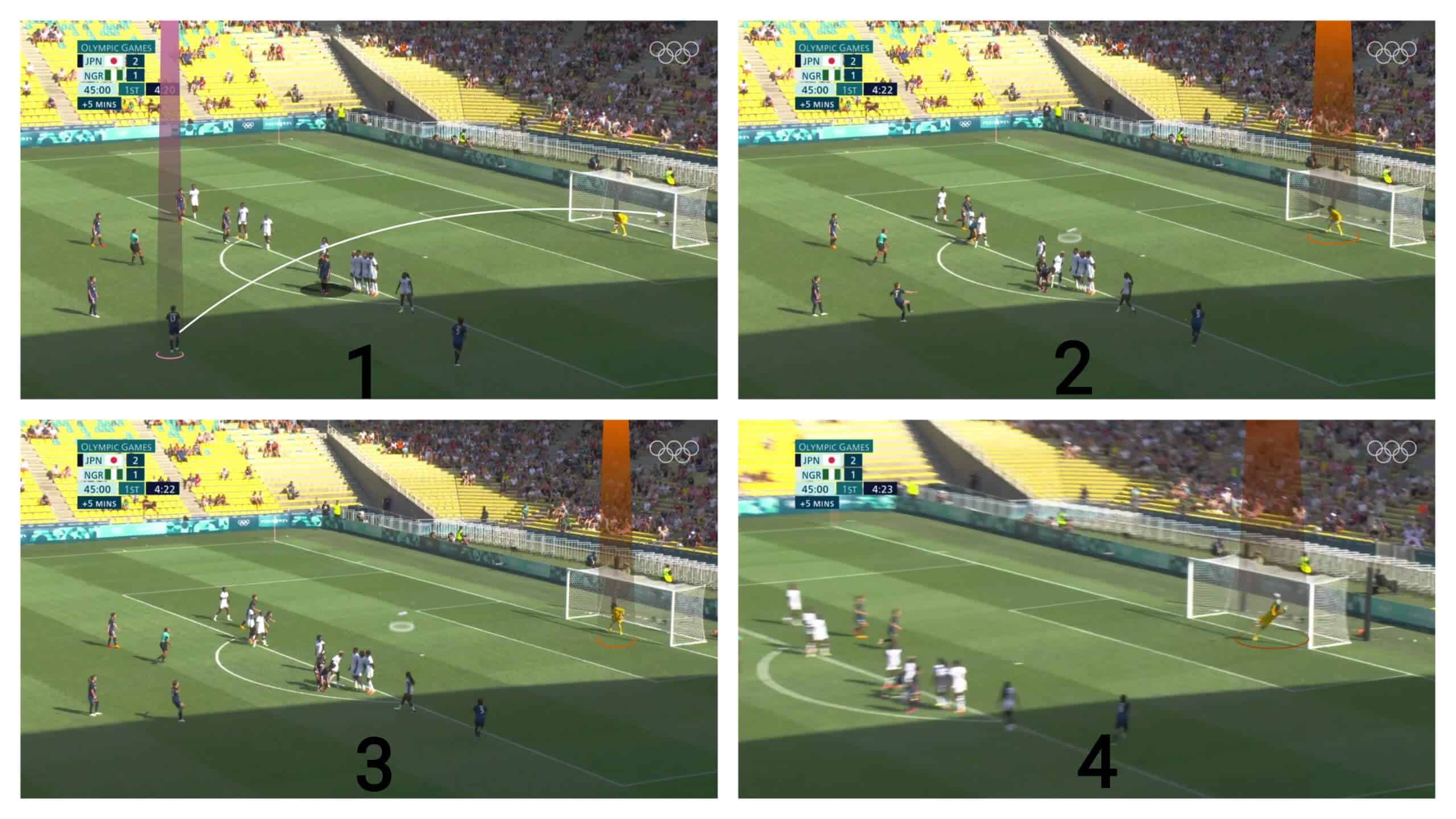
Spain Vs Colombia
Spain, who also got the full nine points, are diverse in their ways of attacking corners, so they can target the near or the far posts through direct crosses or short passes.
Let’s start with the near post.
In the first photo below, the opponent follows the man-marking defending system with only two zonal defenders in green.
In this routine, Spain have three main yellow players: the farthest one is the targeted one who runs in a curved way around her teammate who goes to block her marker, a screen.
When he turns around with the targeted player, she suddenly finds this mate in her face while the first yellow attacker stands in front of the zonal defender to block her, preventing her from going to the targeted area, as in the second photo.
The plan works despite the low-level cross in the third photo below, but the goalkeeper saves the ball brilliantly, as in the fourth photo.
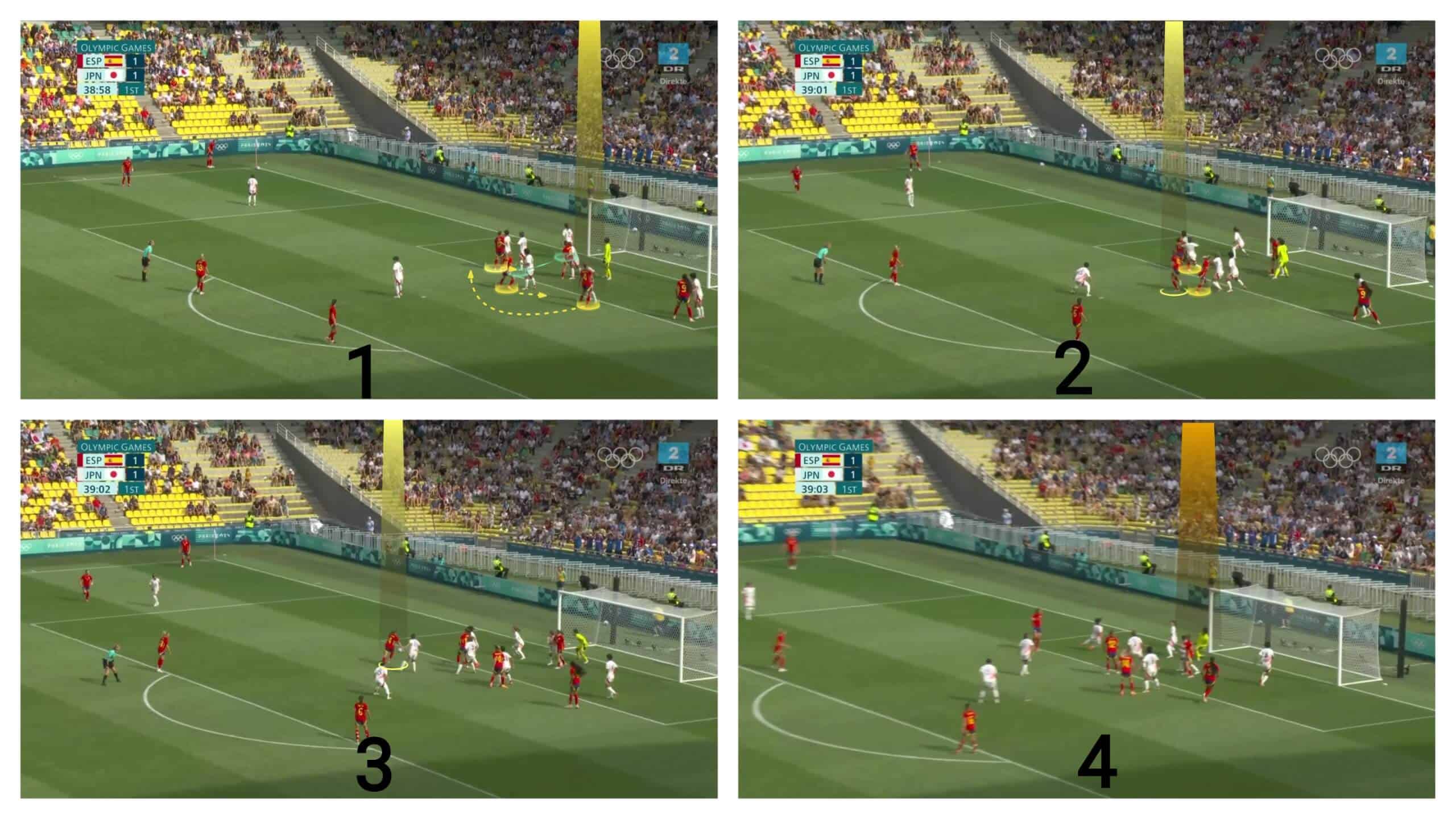
Going to the far post, they use a two-player pack with the same idea:
This teammate blocks the targeted player’s marker at the moment she tries to turn around and follow her, as done in the second photo below.
However, the last zonal defender annoys her, so the ball goes outside, as in the fourth photo.
So, we suggest blocking that one, as done with the first zonal defender in the previous case.
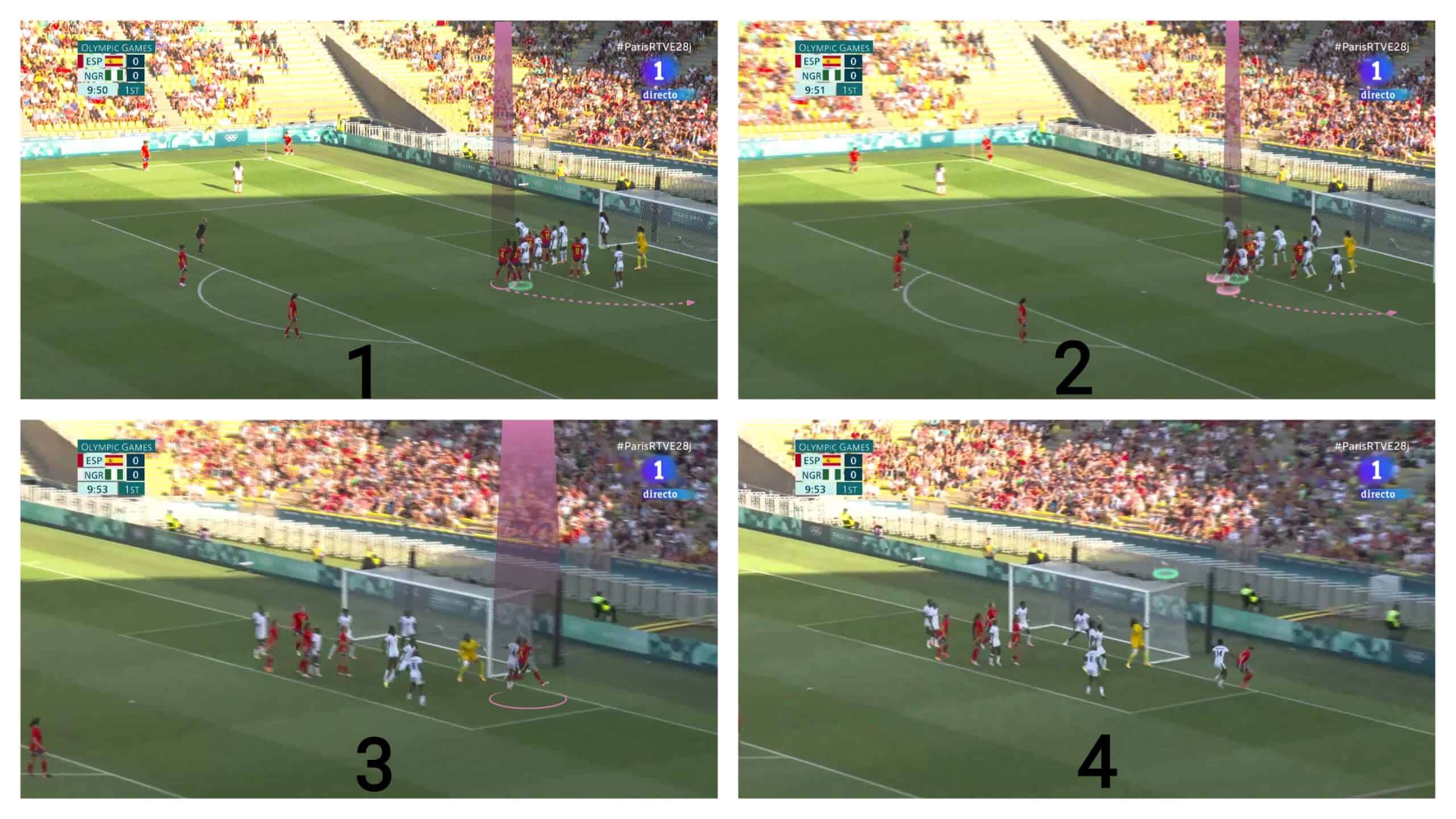
Going to short corners, they are very diverse in using them.
Their first routine is asking the taker to pass the ball to a very near short option and then overlap.
This overlap puts the short-option defender in an urgent 2-v-1 situation while two players stand on the edge of the box to fix the rebound defender so that she won’t go to the gap shown in the first two photos below.
Pushing up when the ball is passed back is a very high-level action, so only well-trained teams can do that properly, keeping the line organised without gaps.
In the third photo below, you can notice the near-post gap due to the divided two levels on the line.
They exploit that, as in the fourth photo below.
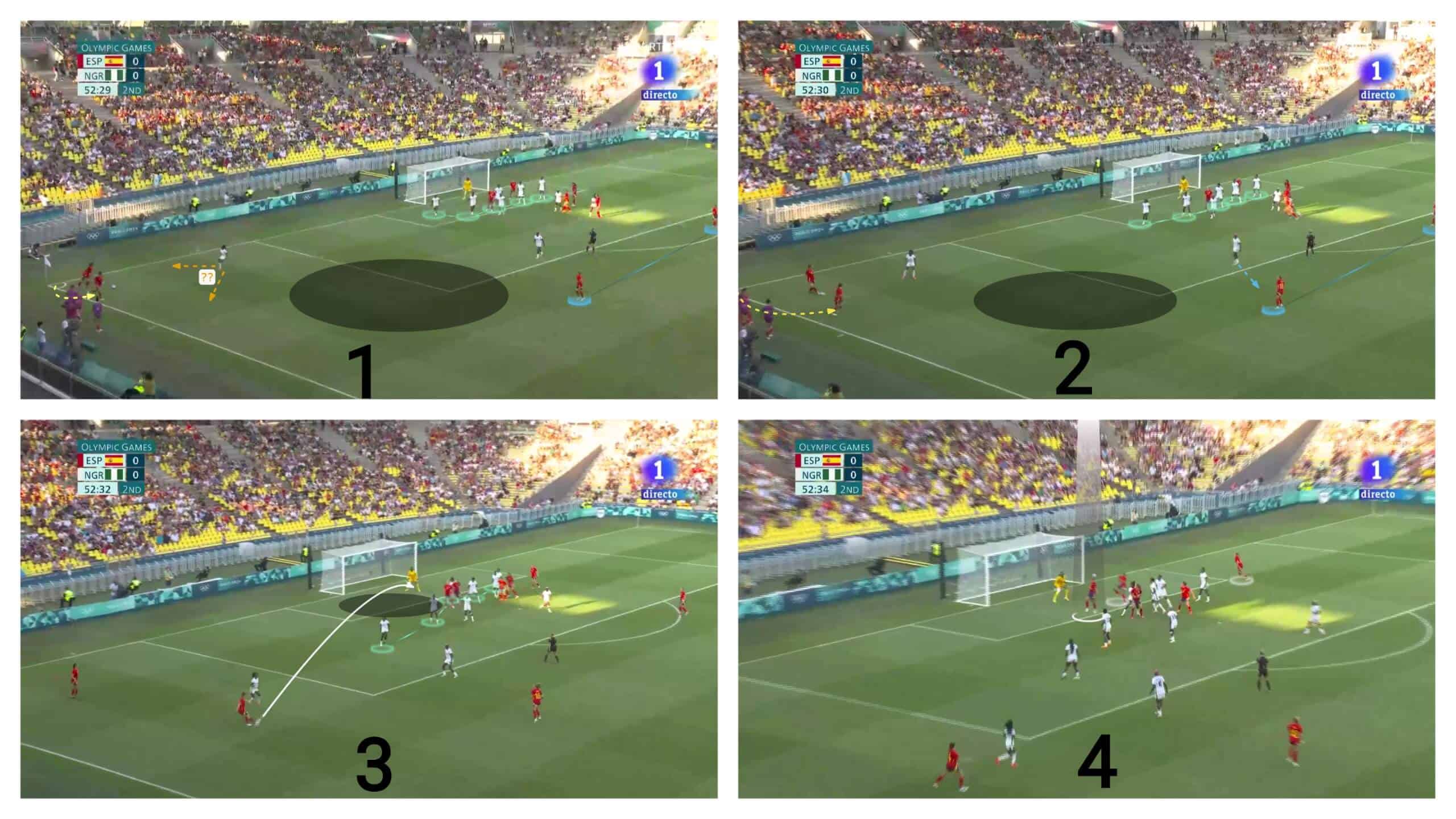
Similar to the photo below, they can ask the short-option to stand on the line, attracting the short-option defender to create the same gap for the taker, who can cross or dribble to shoot the ball directly.
Moreover, they can pass the ball quickly for any short option in the box while the defending team isn’t organised yet, so defending teams must take care!
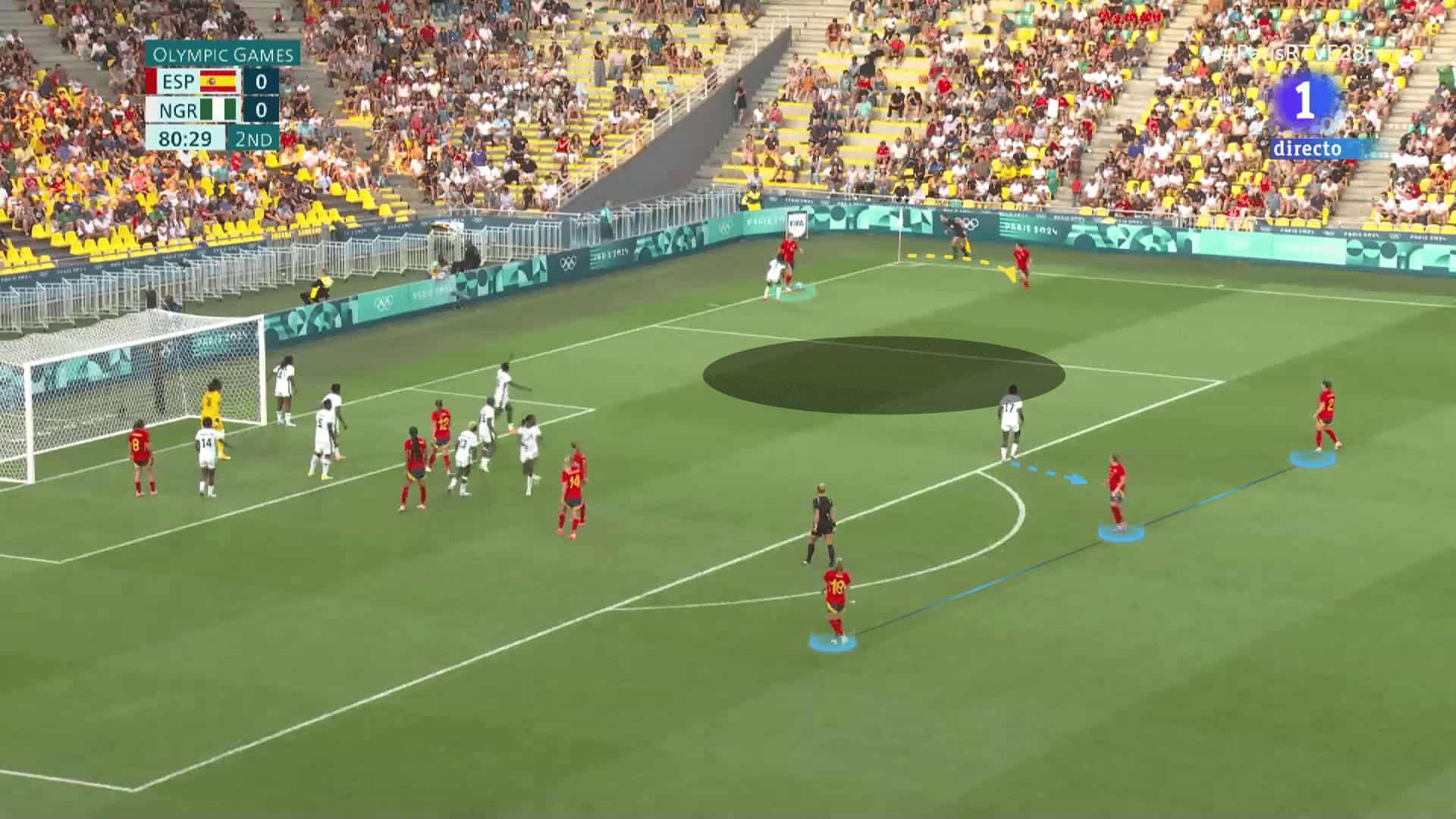
Colombia had a good idea to ask the targeted player to stand in a far position on the edge of the box so as not to take the attention of the player markers who start to mark the players inside the box, leaving her free, as in the first photo below.
After that, the first runner blocks the zonal defender in front of the targeted zone while the other three runners drag their markers away to open the path for the late targeted player, as in the second photo.
The plan works, so the targeted player hits the ball, but it hits a defender, as in the fourth photo.
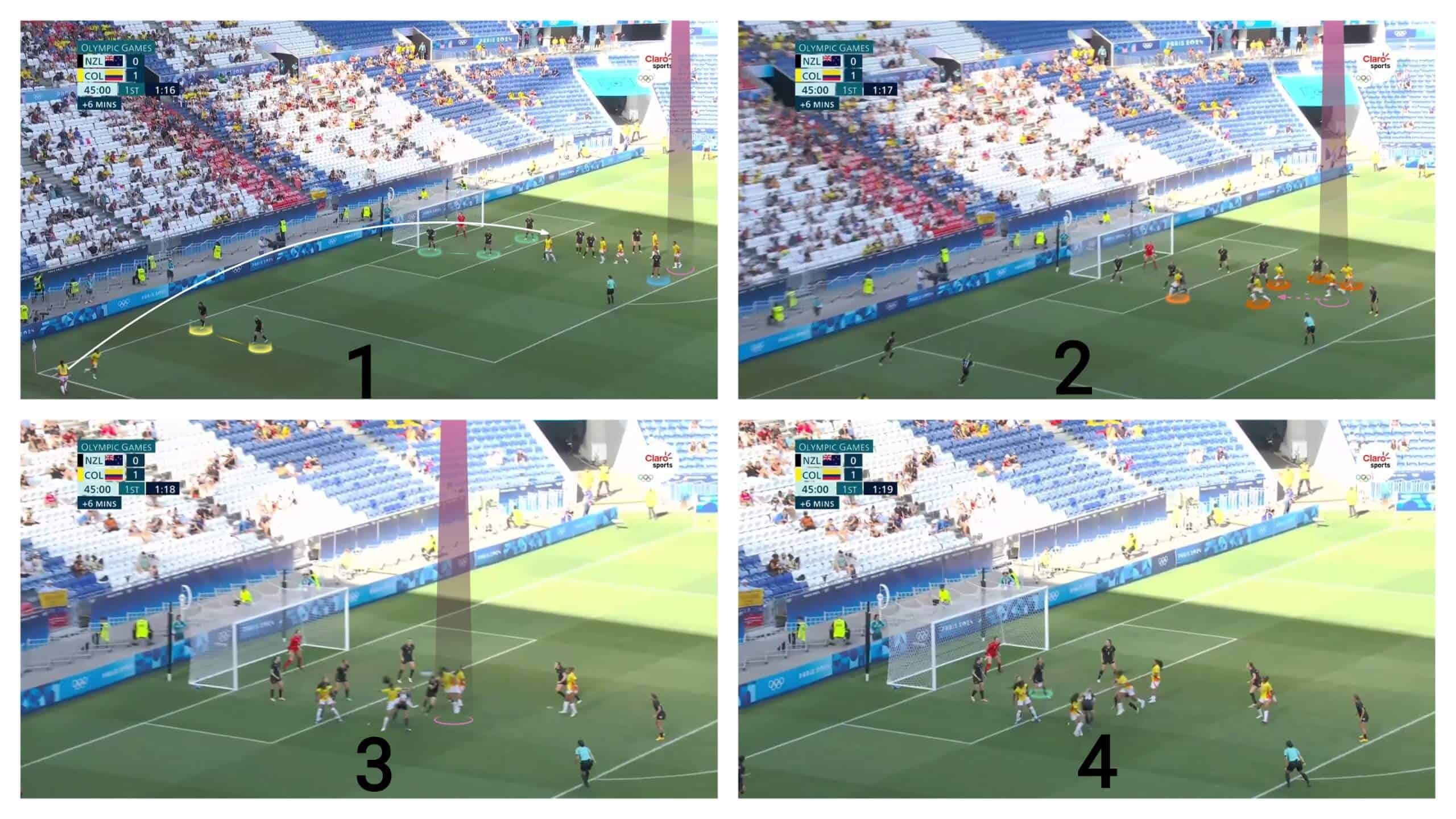
Germany Vs Canada
Regarding Germany, we should anticipate further excitement in their set-piece executions following their amazing performance in the group stage.
They scored three goals from corner kicks and were the team with the highest number of goals from corner kicks.
In the photo below, Australia is in a zonal-marking system with six zonal defenders in the first zonal line, three zonal defenders in the second zonal line, and a short-option defender.
After knowing the defending scheme, let’s move on to our topic: the starting positions of German players.
You have three seconds to guess where you saw it before.
Yes, it looks like Arsenal’s starting positions, but what is the purpose of that?
Germany asks four of the five attackers in the box to stand on the blind side of the whole defence block, meaning that all the defenders can’t follow the ball in the air and the attackers behind them at the same time.
This is called an orientation problem, and Germany can easily decide the victim is coming from his back and win the duel.
Here, Germany uses the underloading principle, meaning that they will target the area they stand at in the beginning by the last standing attacker asking the attackers behind them to run inside manipulating the defenders’ attention.
Let’s track every one of the five.
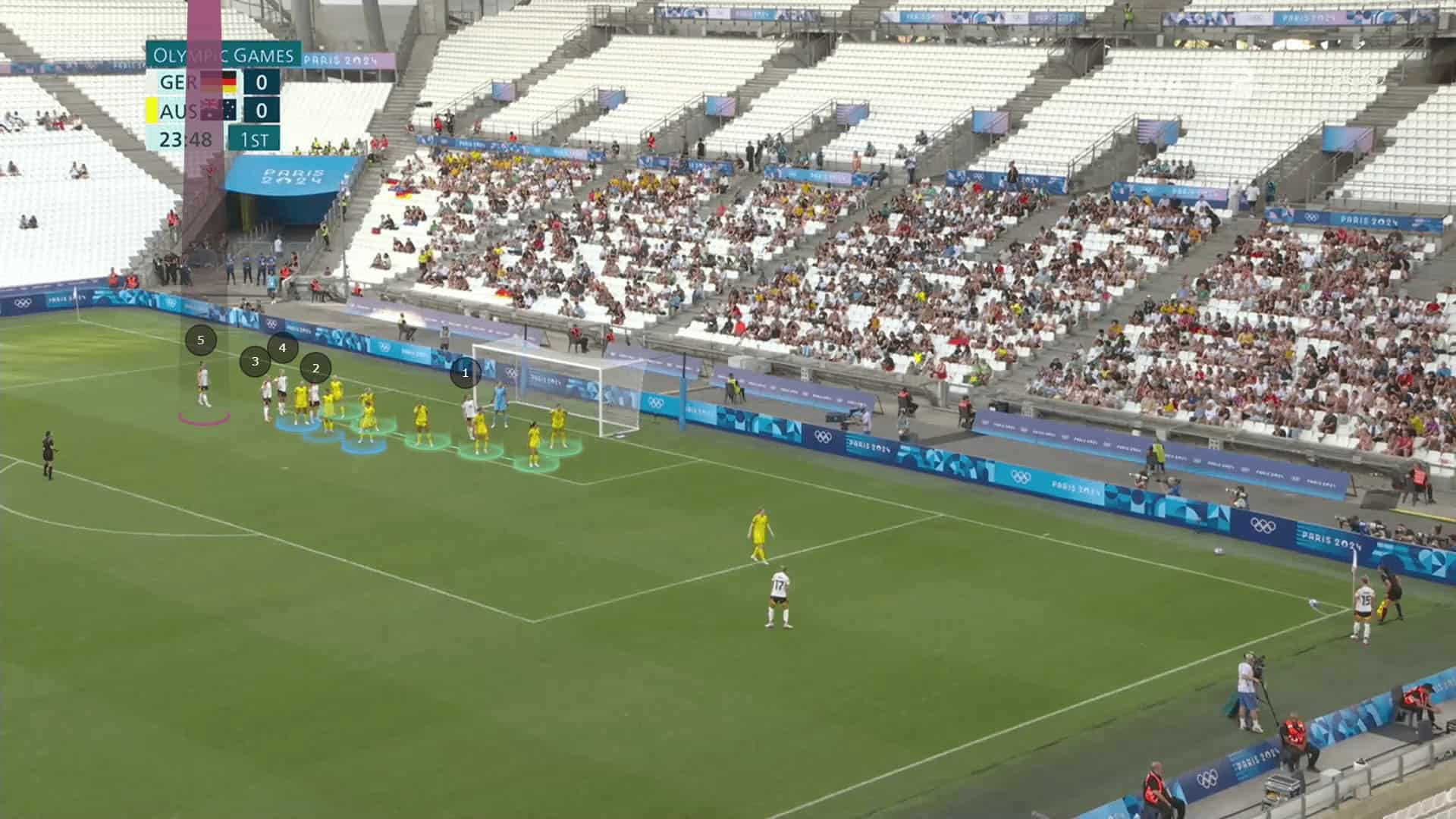
The first one comes from the six-yard line to manipulate the defenders, trying to hide her intention of targeting the far post, while the second player follows her, but from a far position, taking a strange path and trying to draw the attention of some defenders.
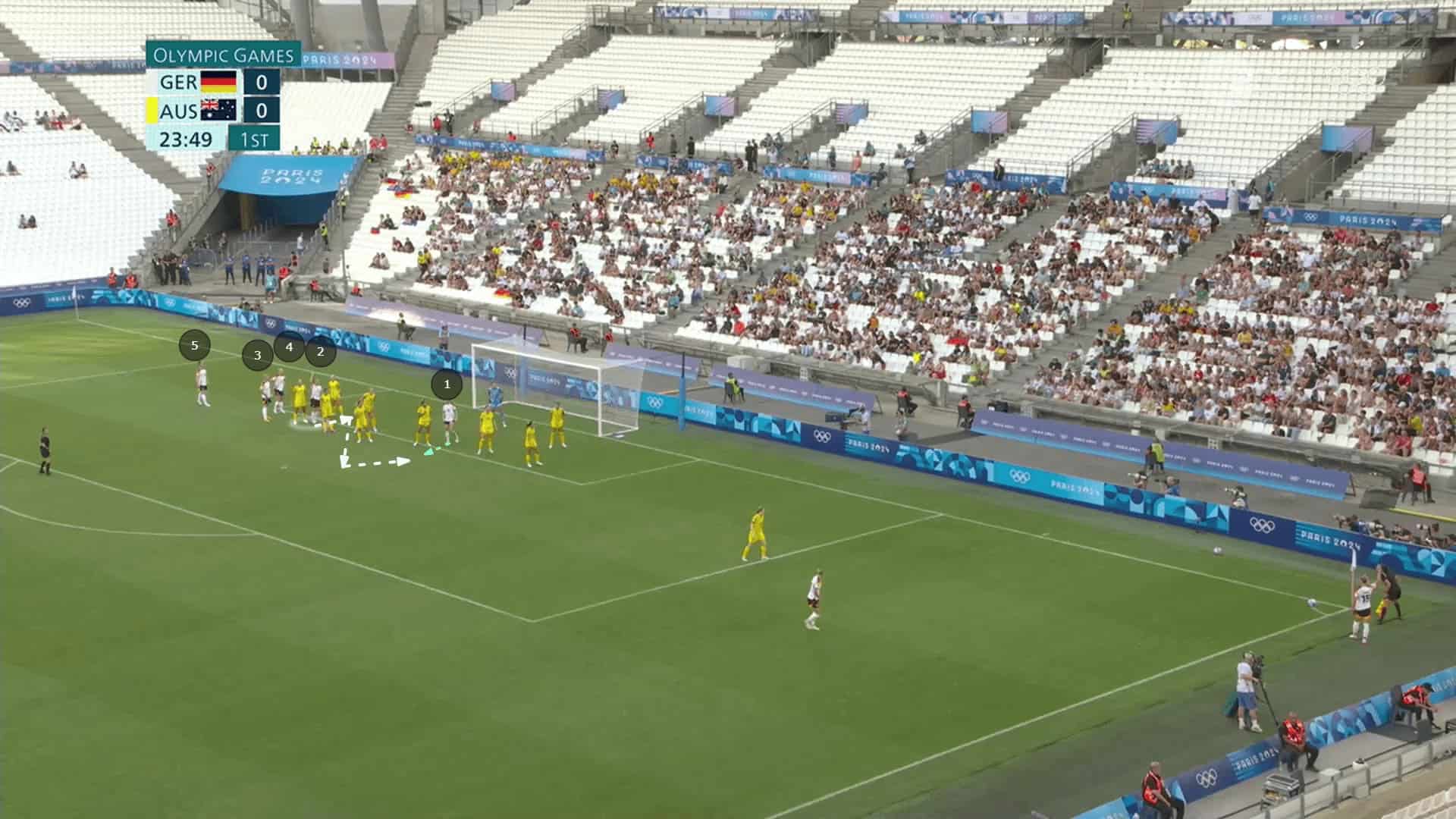
The third and fourth runners are asked to run in shown paths to take the attention of the last zonal defender in the first and second lines to free the last runner who starts to run late, as in the two following photos.
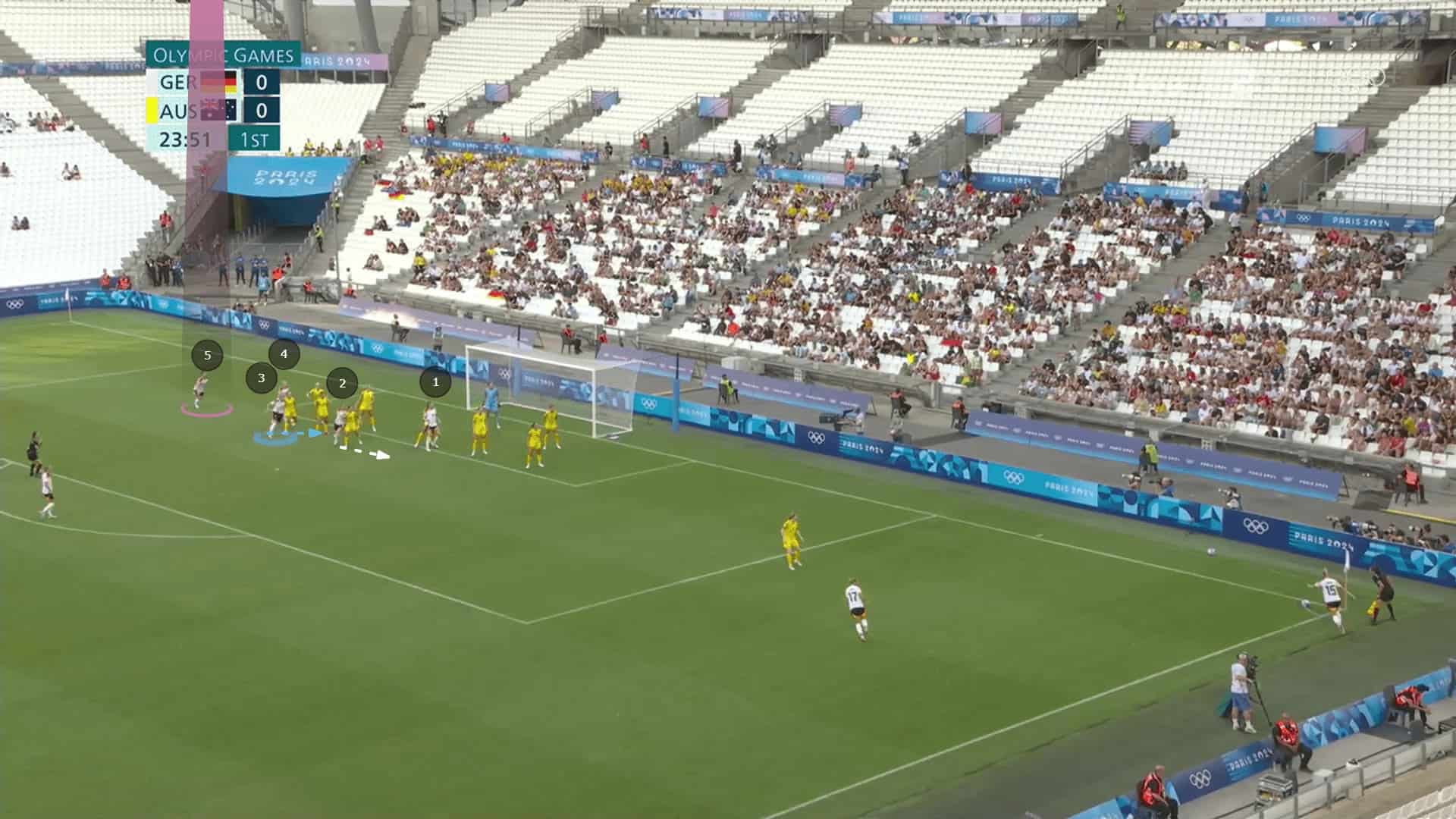
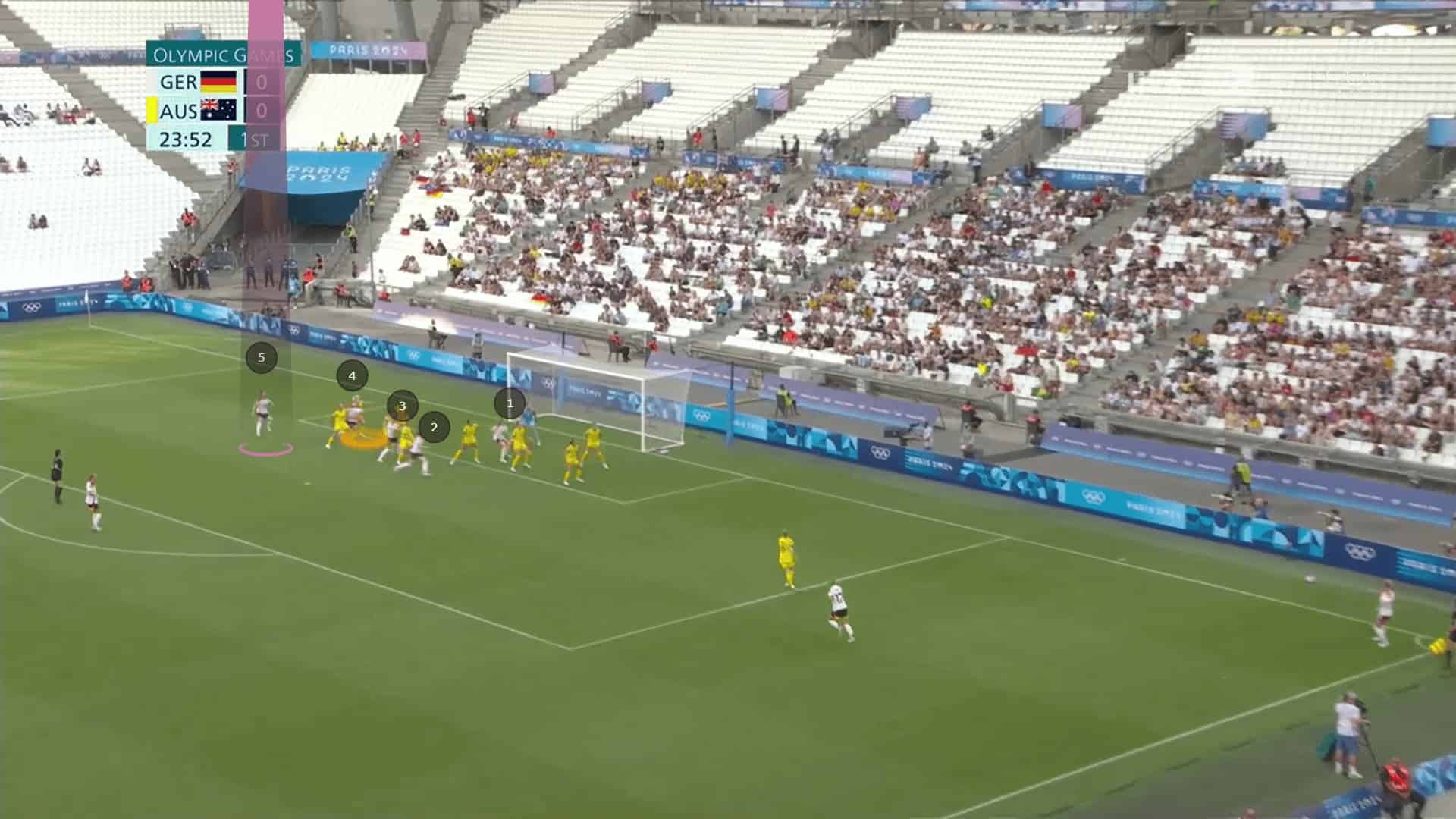
Now, the last zonal defender in each line realises the trick, but one of the benefits of the starting position, which causes orientation problems.
They are forced to step with their backs to keep looking at the ball while the sight is open for the targeted player who comes free, measures the ball, and scores a goal, as in the two following photos.
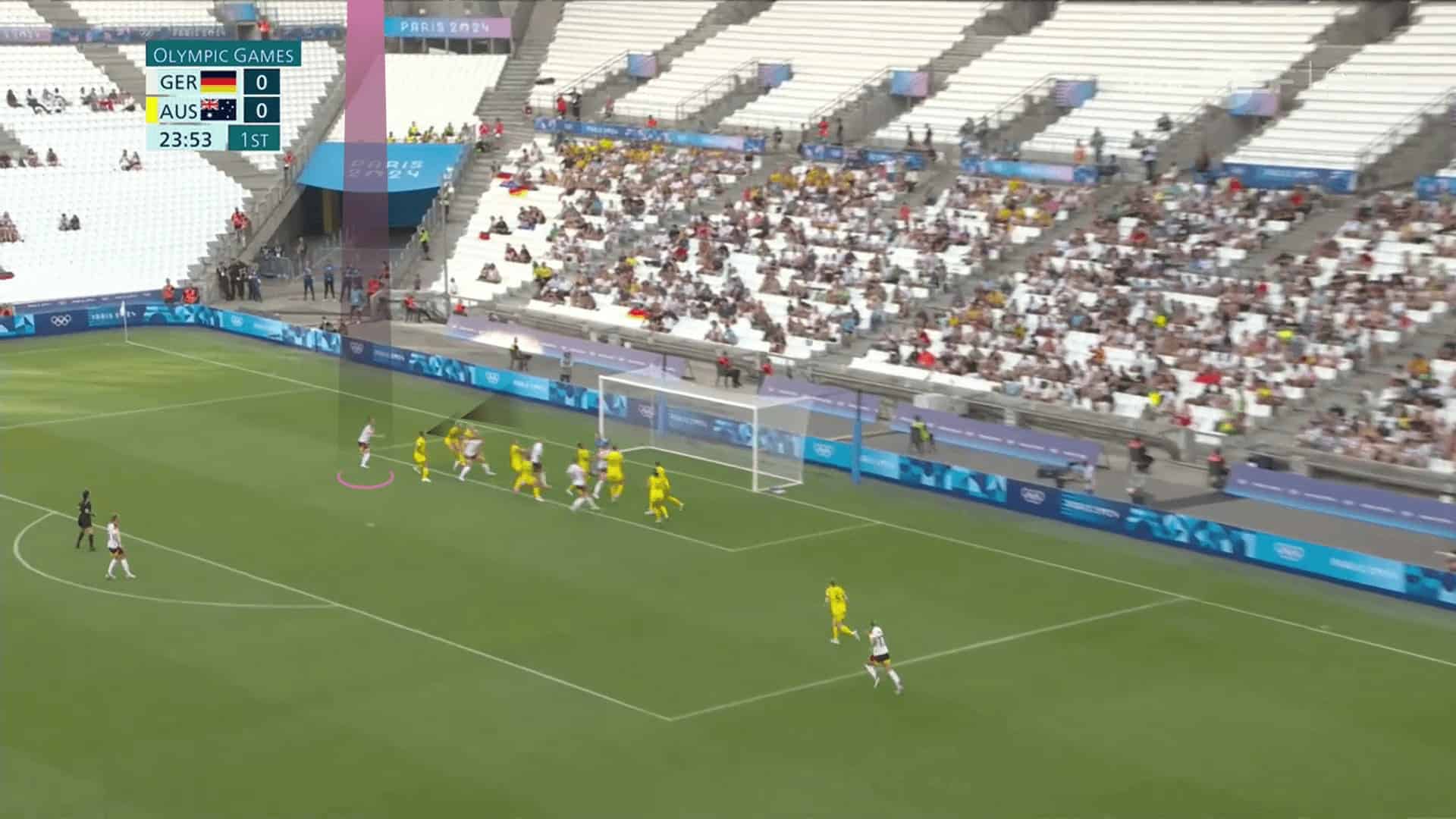
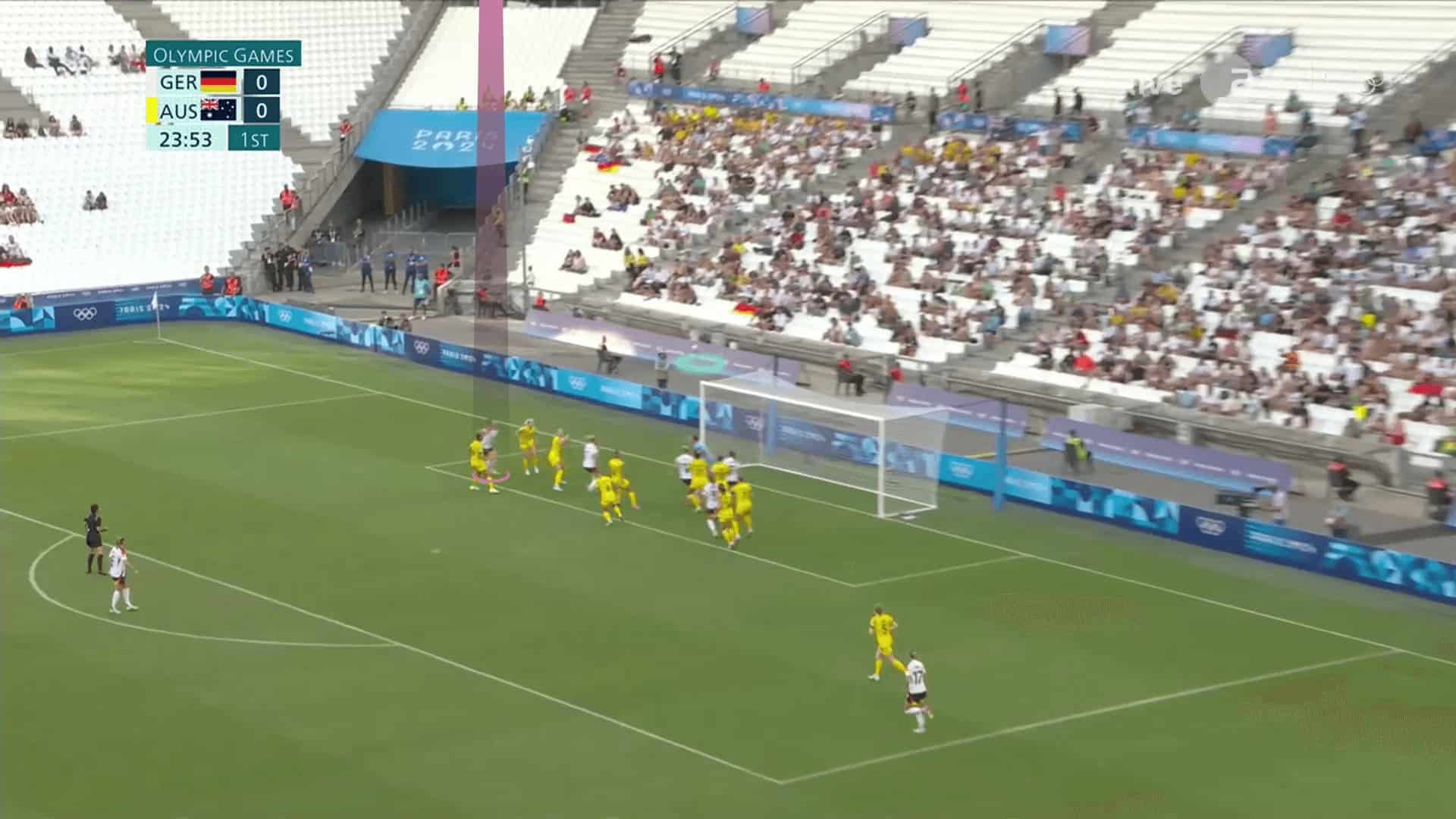
They can use this strategy to target the middle and the near post, using the same principles: orientation problems and manipulating runs.
They also have another strategy to crowd the six-yard at the beginning.
In the first photo below, the opponent has two post players and four-player markers with four attackers inside the six-yard which is so difficult for the goalkeeper and causes wanted chaos.
Moreover, they use a small short pass before crossing to test how the opponent will push up.
Here, two player markers leave their marker to push up, leaving the two attackers free, as in the second and third photos.
It ended with a dangerous chance with the ball hitting the post, as in the fourth photo.
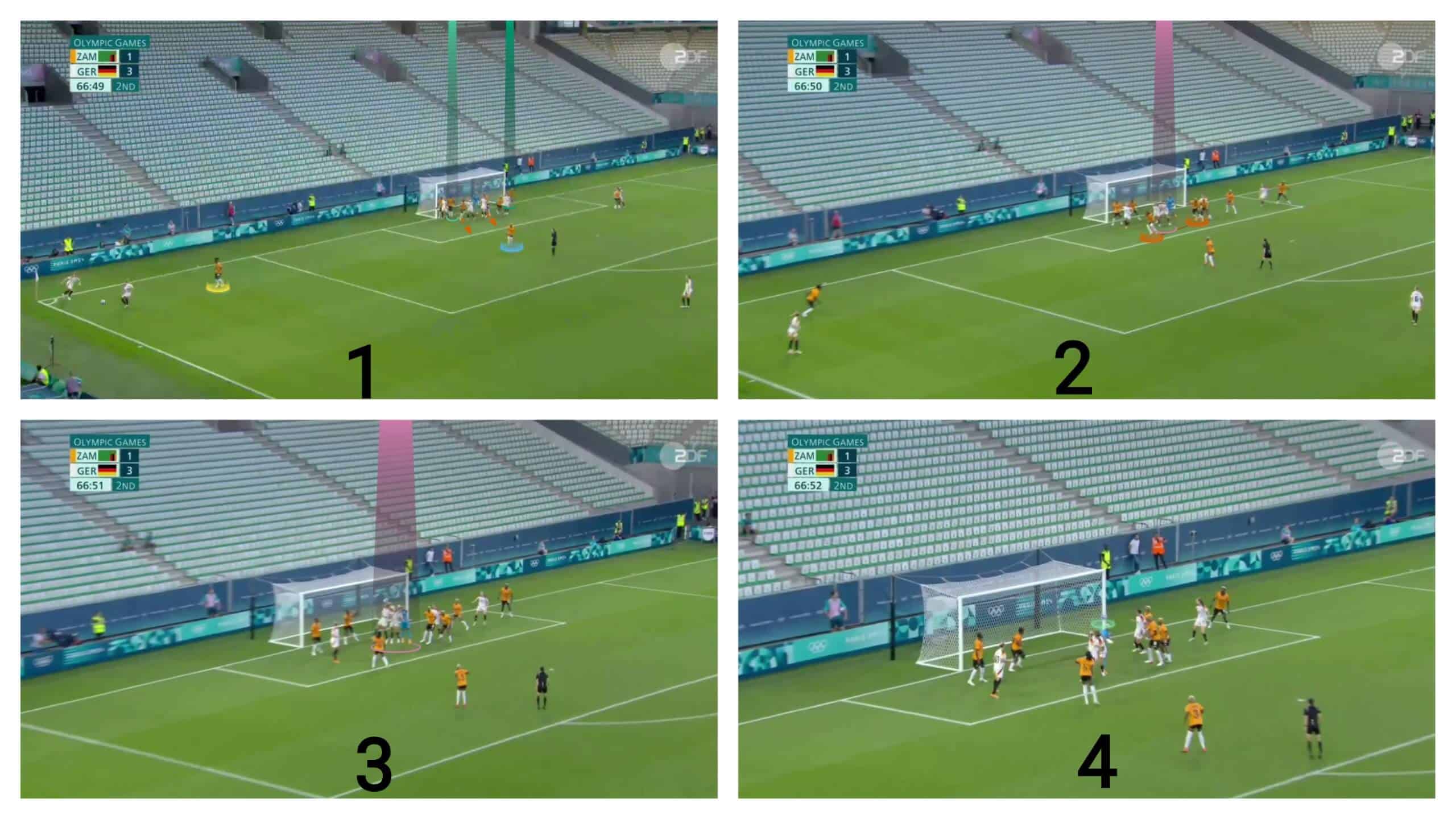
Regarding Canada, they usually target Vanessa Gilles in the area in front of the near post, from the edge of the six-yard to the penalty pot.
Let’s see examples!
In the first photo below, the opponent defends with a player-marking system with only two zonal defenders, two short-option defenders, a rebound defender and five player markers.
In the second photo, she stands behind her mate to use her as a screen while a green player moves from the six-yard to take the attention of the first zonal defender.
In the third photo, the targeted player becomes free because her marker is forced to move from the other side.
The plan works, but the cross is inaccurate, as in the fourth photo below.
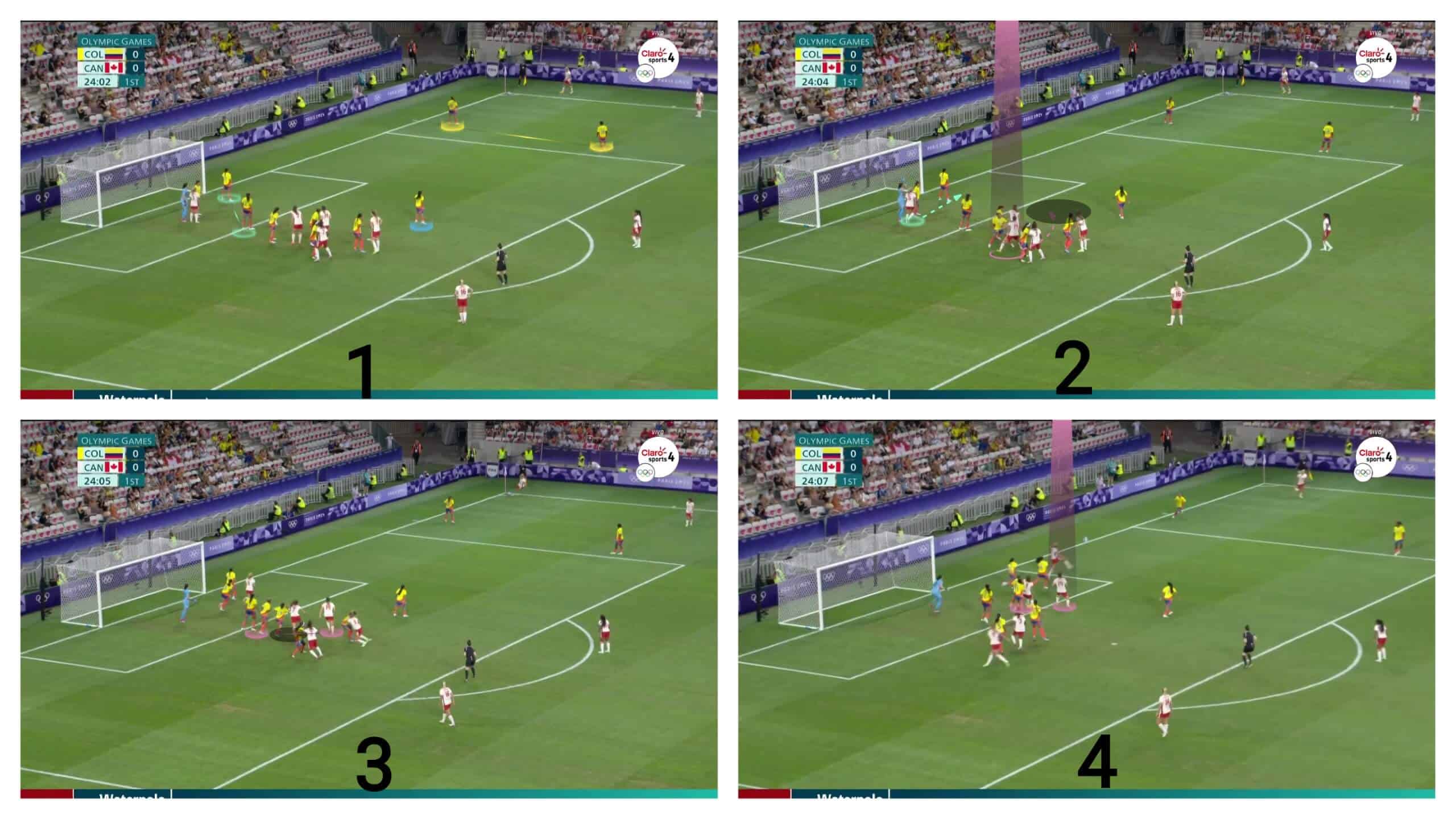
They use the same plan in different ways. In the photo below, the cross is a little farther and nearer to the ground to be shot before the second zonal defender comes, as shown in the two photos below.
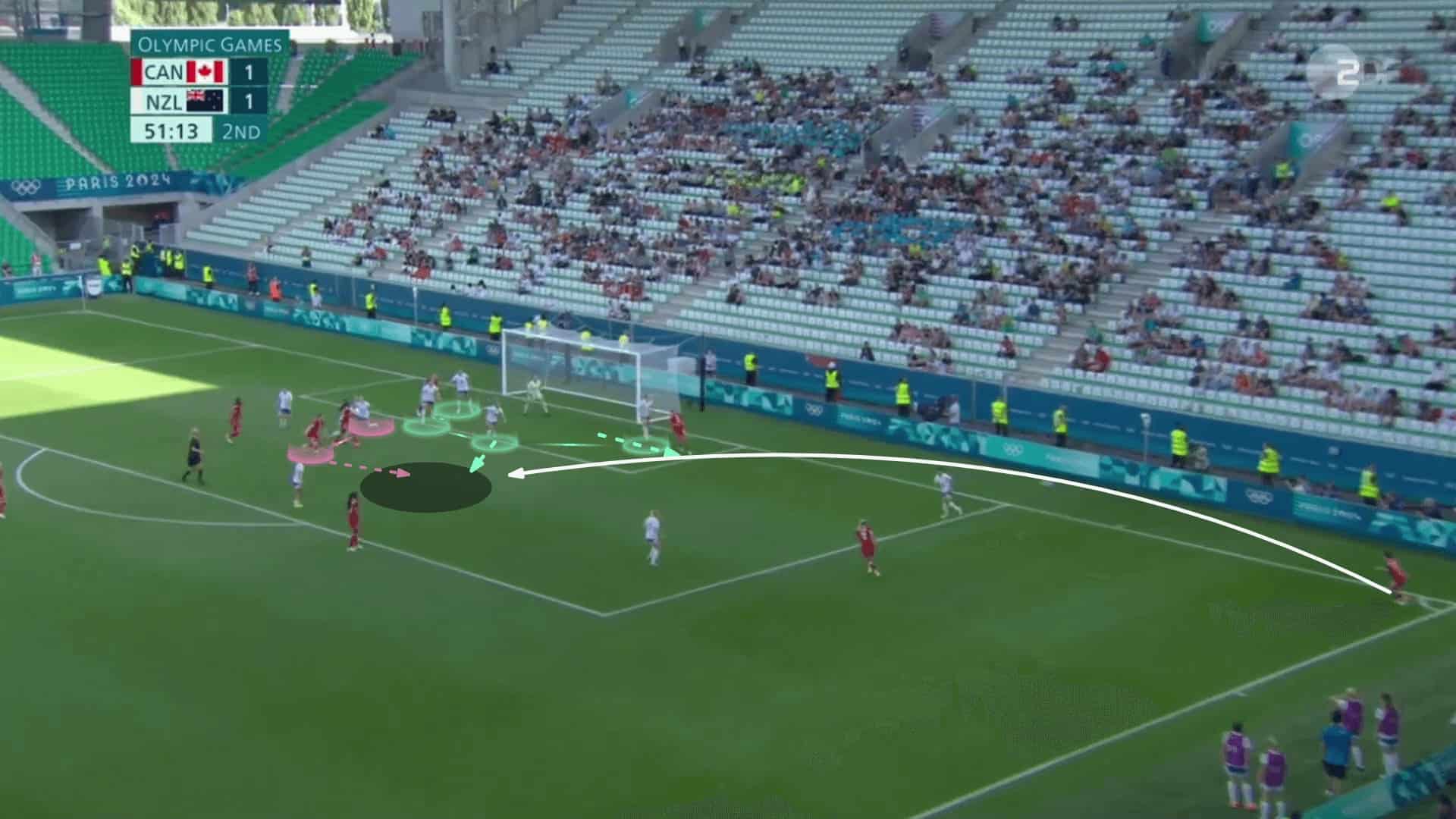
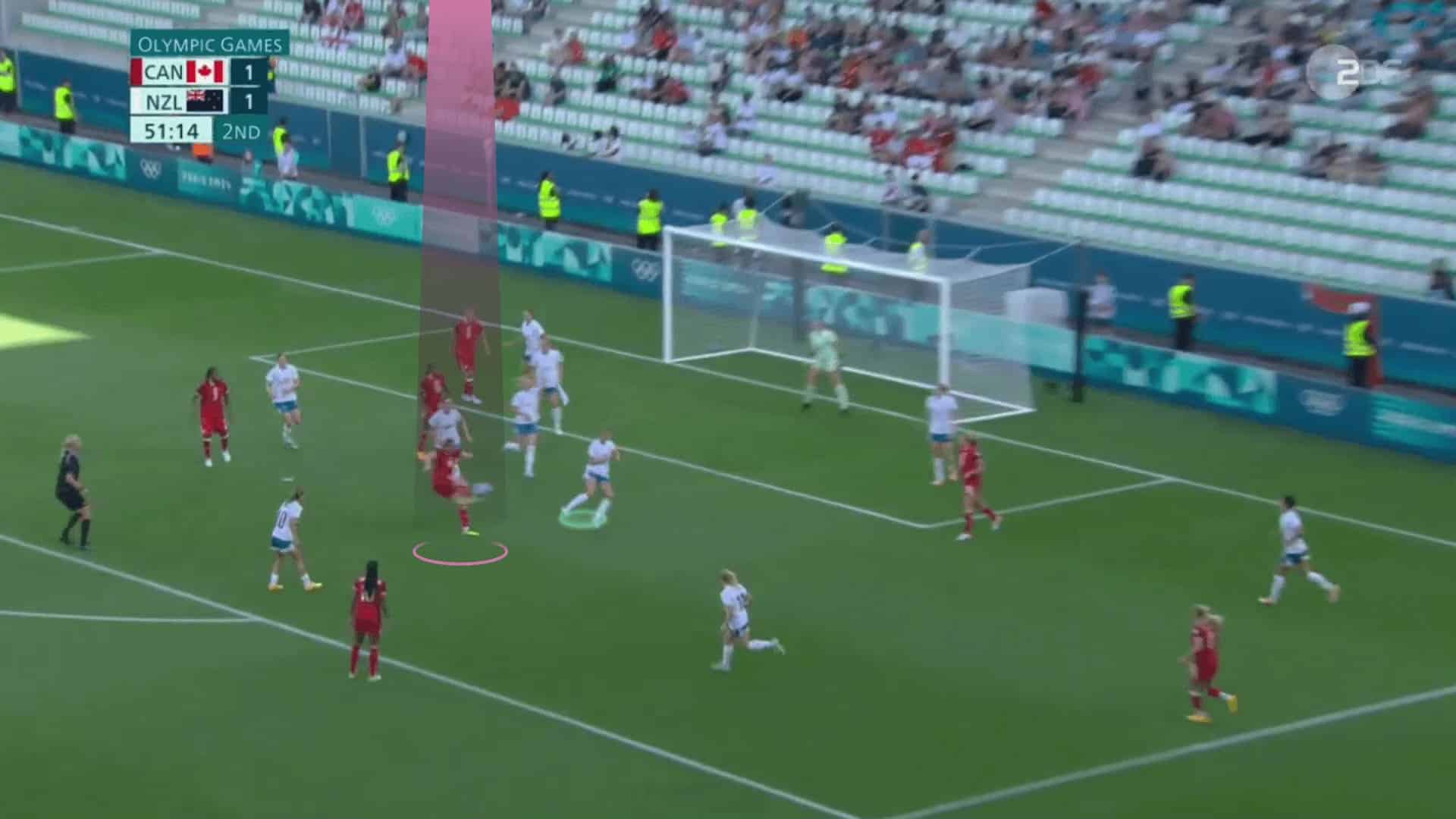
France Vs Brazil
France depends on two principles, underloading and orientation problems, to target the far post differently.
As shown below, they ask two players to start in the targeted area and then underload it so that it is free for the targeted player while not being a clear target from the beginning.
Regarding the orientation problem, the targeted player stands in a far position in the middle and then runs toward the far post, which means that the marker should turn around, giving her back to the ball.
When he decides to look at it again, he loses communication with the attacker for a moment, as in the second photo below.
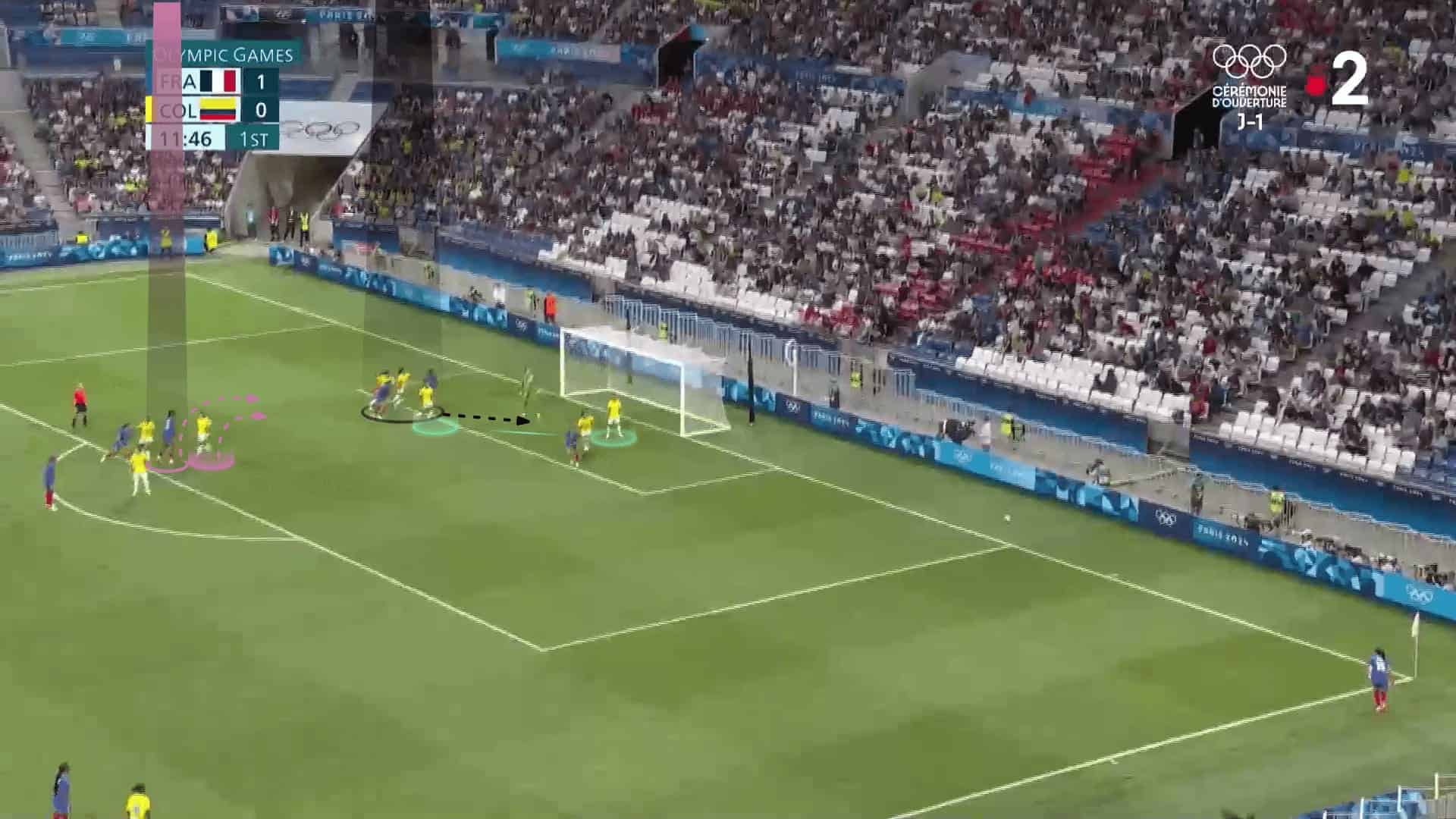
The targeted player wins a moment before the marker, and the plan works, but the goalkeeper brilliantly saves it.
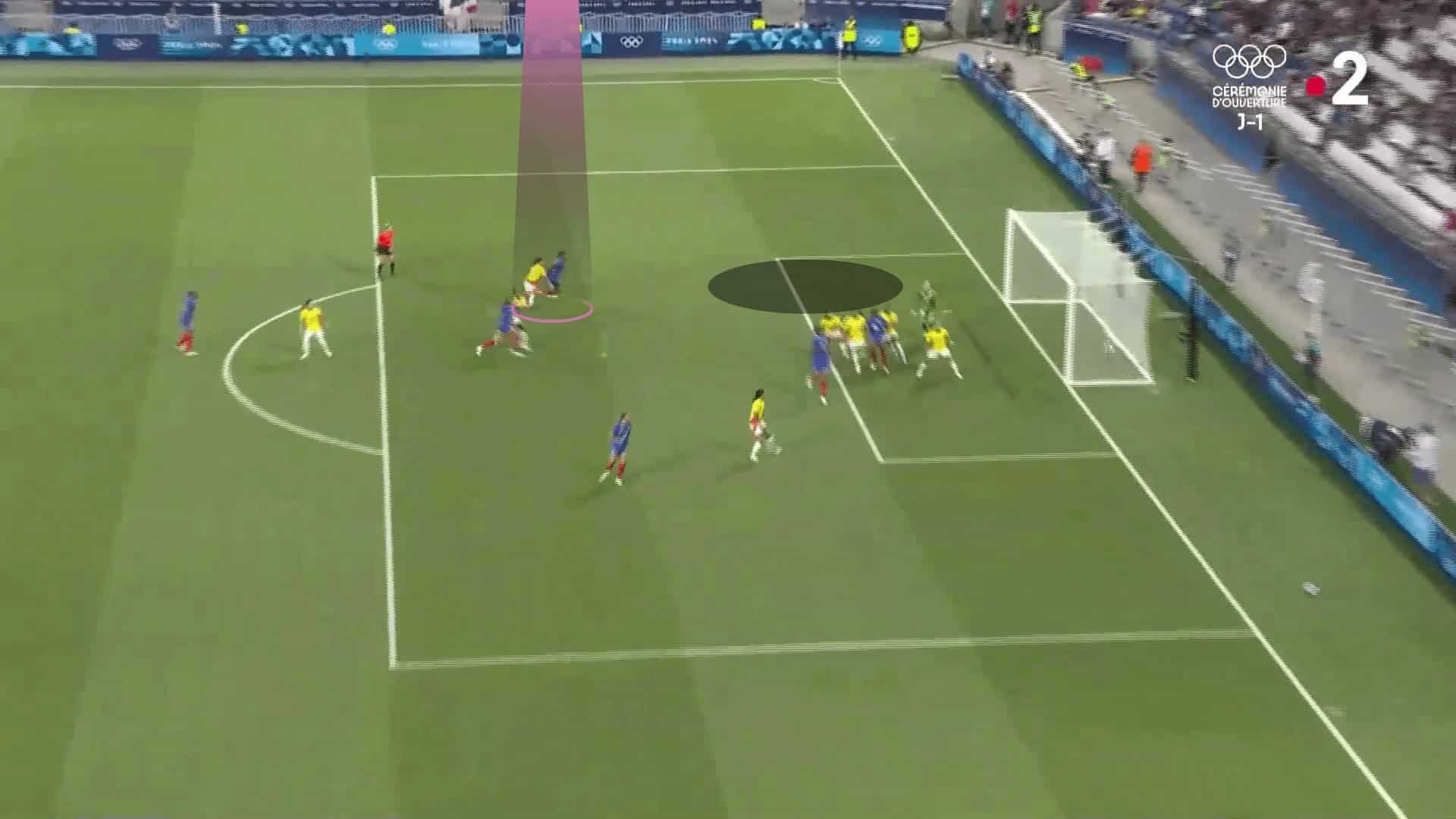
Regarding Brazil, they had a good routine, which is ” using a fake short run to target the near post”.
In the photo below, Span defends with three zonal defenders.
At the same time, the first one is asked to go to help in case of short corners to be 2v2 when the taker gets involved after the pass, so Brazil fakes a short movement only to drag the first zonal defender to empty the area on the near post, as shown below.
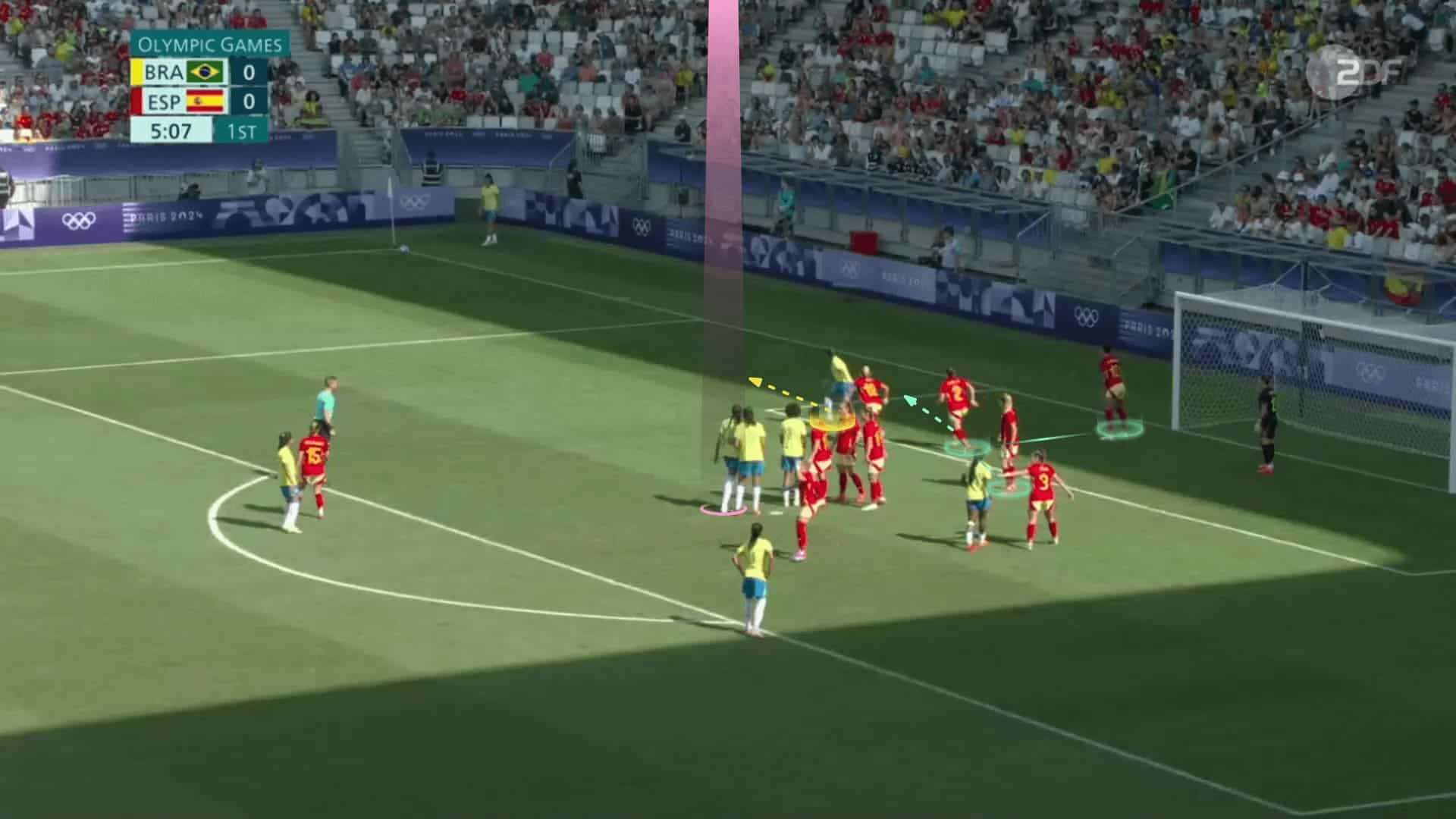
The targeted area becomes empty, but the targeted player has a marker with her.
This makes it harder for her to deal with the cross, as in the two photos below, so we suggest using a mate to do a screen to free the targeted player.
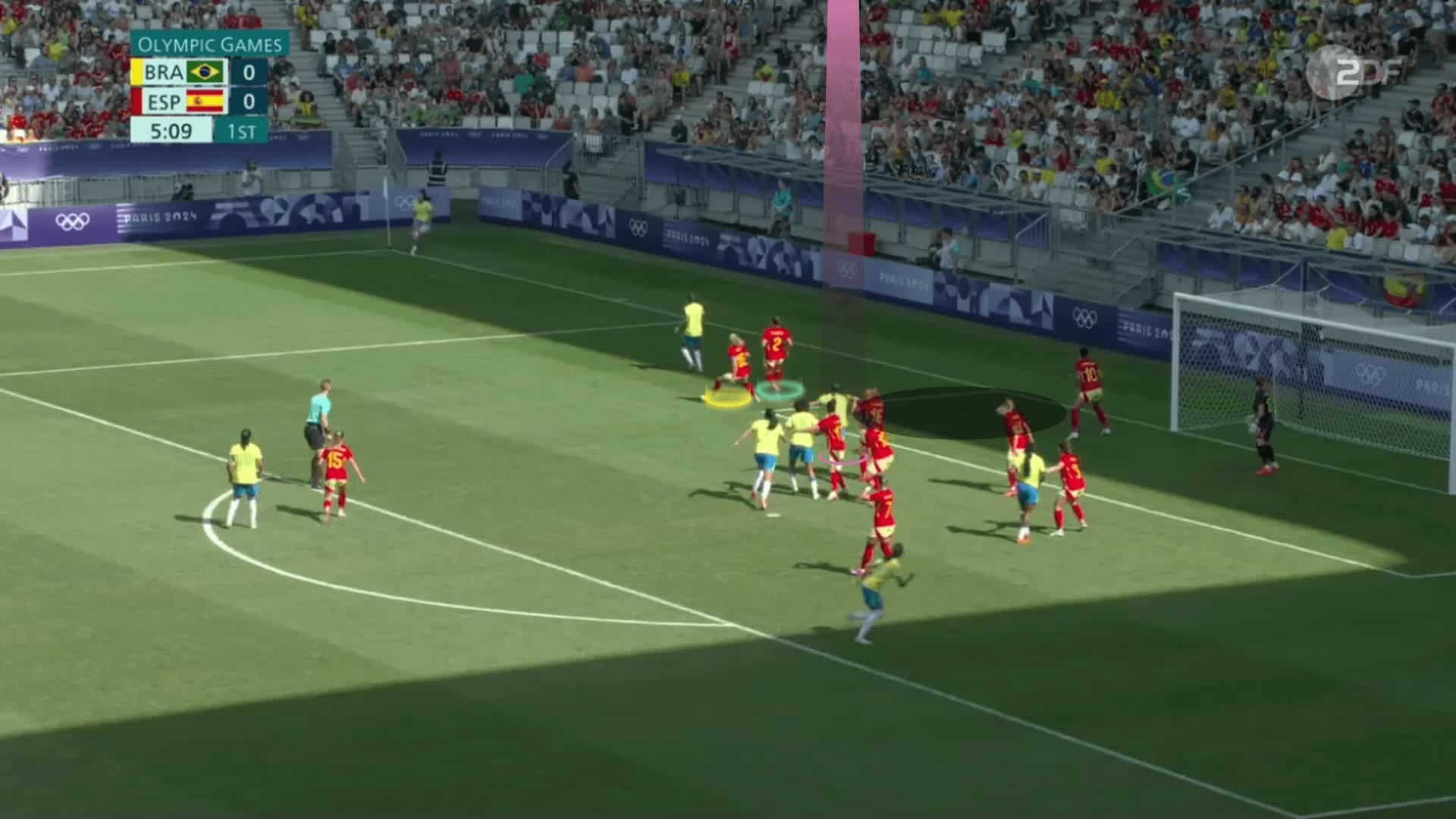
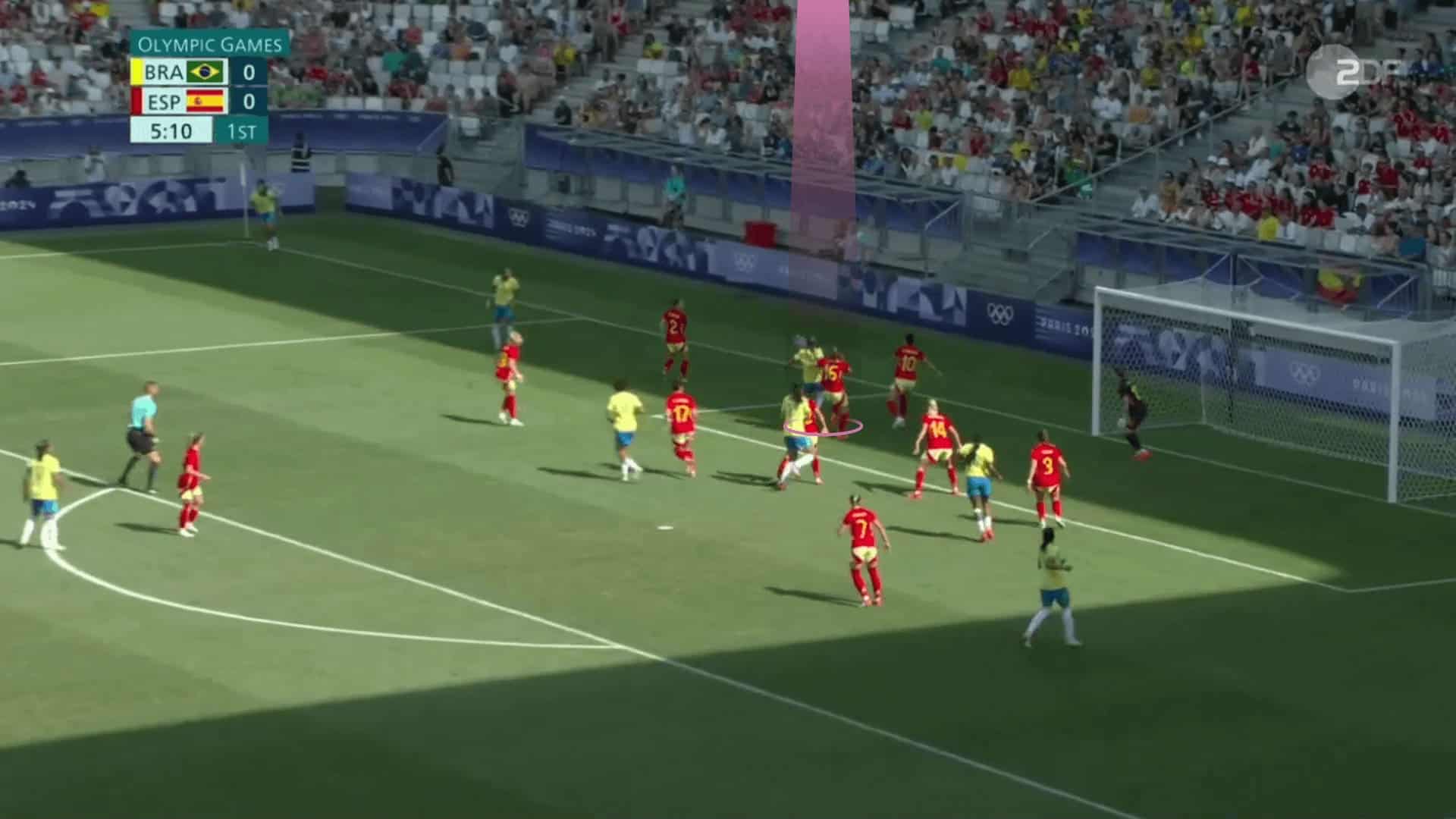
Conclusion
In this analysis, we have illustrated the key distinguishing tactics of each of the final eight’s set-pieces in Olympic Women’s Football 2024.
In this set-piece analysis, we have also shown how each team can threaten the goals through set plays, which is so vital in knock-out tight games.






Comments